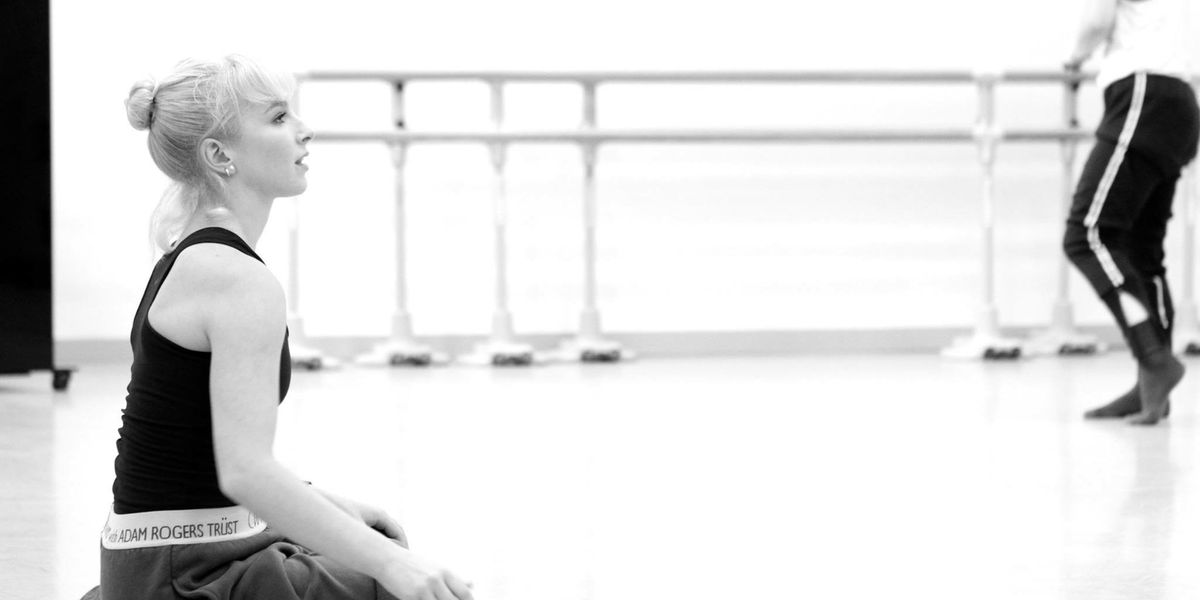Charlotte Edmonds, The Royal Ballet's Inaugural Young Choreographer, Gets Ready to Spread Her Wings
Wearing leggings and a puffy vest as she works in one of The Royal Ballet’s light-filled studios, Charlotte Edmonds could pass for a corps de ballet member. Instead, she is choreographing on them, creating dynamic, ballet-based contemporary dance in her role as the company’s first-ever Young Choreographer.
“At the Opera House you have dancers who have 20 years more experience,” she says. “I bow to their experience, but I also try to hold the room. It is sometimes quite nerve-racking! But it is always exciting.”
Edmonds’ uncanny instincts for choreography and leadership were already apparent at age 11, when she was a first-year student in the Royal Ballet School’s Lower School—and a finalist in its competition for the Ninette de Valois Junior Choreographic Award. She got her first professional commission at age 16, and was barely 19 when Royal Ballet director Kevin O’Hare named her the inaugural recipient of the company’s Young Choreographer Programme. The paid position provides her with studio space, access
to dancers and the mentorship of renowned choreographer Wayne McGregor.
 Photo by Alice Pennefeather, Courtesy ROH
Photo by Alice Pennefeather, Courtesy ROH
Now 20, Edmonds is working part-time with The Royal while transitioning into a freelance career. And at an age when most budding dancemakers are just beginning to experiment on their friends, Edmonds is on a first-name basis with some of the most famous people in ballet: Crystal Pite, Liam Scarlett and Christopher Wheeldon.
Edmonds admits that it’s all a bit surreal. “In my first company meeting, I had this list of things I really wanted to cover. It said, ‘How do I get in touch with Wayne McGregor?’ When I was talking, I could see Wayne reading the list. After I’d finished, he’d written his email down and ‘That’s how.’ I thought, ‘I can’t believe that just happened.’ ”
“You have to keep on reminding yourself that she’s the age she is,” says O’Hare. “She is quite phenomenal, the way she behaves, how she organizes herself, how she deals under the pressure.”
From Dancer to Dancemaker
Edmonds didn’t start out wanting to become a choreographer. She fell in love with ballet at age 4, and auditioned for the RBS’s four-year Lower School, at White Lodge, at 10. “When I first came to White Lodge, I really wanted to be a professional dancer,” she recalls.
Like many petite dancers, though, the 5-foot Edmonds felt that her size wasn’t helping her. “In my last two years, I really wasn’t being cast in anything, I think because of my height. So I used that time to experiment. I used to put my music on and dance for hours. From then my interest kind of naturally turned to choreography.”
A Valois Award finalist in each of her first three years, she won the RBS’s Kenneth MacMillan Senior Choreographic Award in 2011 and 2012. O’Hare was one of the judges. “It was fascinating the way she used classical language, but with something new and original and fresh,” he says of those early works.
 Edmonds with Royal Ballet dancer Anna Rose O’Sullivan. Photo by Andrej Uspenski, Courtesy ROH.
Edmonds with Royal Ballet dancer Anna Rose O’Sullivan. Photo by Andrej Uspenski, Courtesy ROH.
On the day the RBS informed then-16-year-old Edmonds that she was not promoted into the Upper School, “the tissues were already passed towards me, before they’d even said anything,” she remembers.”But I was fine. Then they said, ‘But there was a conversation about you continuing as a choreographer.’ I burst into tears. That was a really key moment. I knew my interest was in choreography because I got really emotional about it.” She transferred to the Rambert School of Ballet and Contemporary Dance, and O’Hare told her to get back in touch after graduation.
But first, the teenager had to complete her first commission, for London’s Yorke Dance Project. Artistic director Yolande Yorke-Edgell was one of Edmonds’ contemporary-dance teachers at the RBS. “I knew from observing her in class that she didn’t just take a combination and try to do it exactly as I had given it,” says Yorke- Edgell. “She had a way of being creative.”
Her time at Rambert encouraged her unique mix of classicism and modernity. “I learned Cunningham, Graham, Limón. We did a bit of Gaga,” she says, citing Pite, William Forsythe and Mats Ek as additional influences. “We had choreographers come in with their own style. I really like watching to see what resonates with me. Like, ‘I loved the way that they did that turn; I wonder if I could re-create that in my own way?’ ”
While Edmonds says that she is still finding her style, she has a clear sense it is “neoclassical, but it has slightly more groundedness, and really fluid. I also really am inspired by music, so I try to make my choreography as musical as possible.”
Full Speed Ahead
O’Hare believes so strongly in Edmonds that he renewed her Young Choreographer contract for a second year, then transitioned her to part-time for her current, third year. “I have the flexibility to create outside, but I also have a position here,” Edmonds says, “so I can really find my feet.”
Sitting in on rehearsals with McGregor—and emailing him for advice—has helped prepare Edmonds for a flood of small commissions: two dance films, short ballets for the RBS, the Dutch National Ballet Junior Company, Northern Ballet Studio, and a duet for the McGregor-curated Draft Works residency. She created a solo for English National Ballet artist Isabelle Brouwers, who danced The Pelican in ENB’s 2016 Emerging Dancer competition.
 English National Ballet’s Isabelle Brouwers in Edmonds “The Pelican.” Photo by Laurent Liotardo, Courtesy ENB.
English National Ballet’s Isabelle Brouwers in Edmonds “The Pelican.” Photo by Laurent Liotardo, Courtesy ENB.
“I really see her becoming one of the next star British choreographers,” says Brouwers, 21, who was a couple years ahead of Edmonds at the RBS. “You never feel like you’re going to work with her—it’s fun. She allows for us to give our input, and she works with our strengths.”
O’Hare feels that Edmonds’ talent speaks for itself, but acknowledges that “we’re all very much aware of the lack of opportunities, or perceived lack of opportunities, for women choreographers.” Edmonds is frequently asked for her opinion on that issue, which she takes in stride. “I wouldn’t want anyone to commission me just because I’m female,” she says. “But at the same time, there needs to be a balance between men and women. I’m still answering those questions.”
As she clarifies her choreographic voice on the world stage, Edmonds also keeps the pressure in perspective. “With this career, sometimes you never know what you’re doing in the next couple months, which is frightening. But it’s all part of it,” she says. “Obviously, they believed in me, and I needed to believe in myself to continue. I’m just really living in the moment.”






